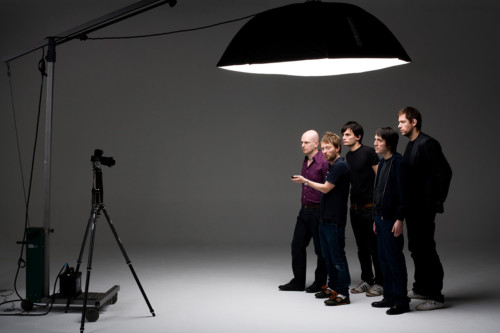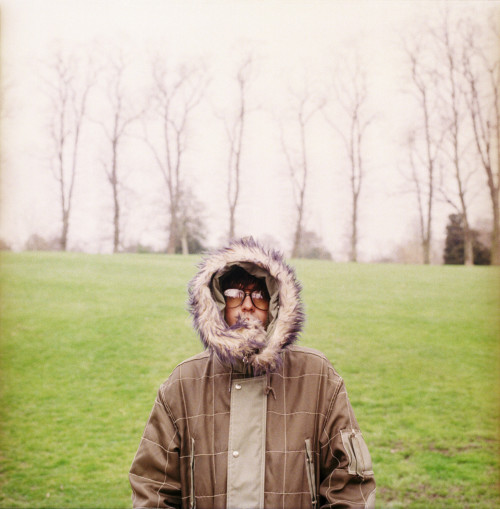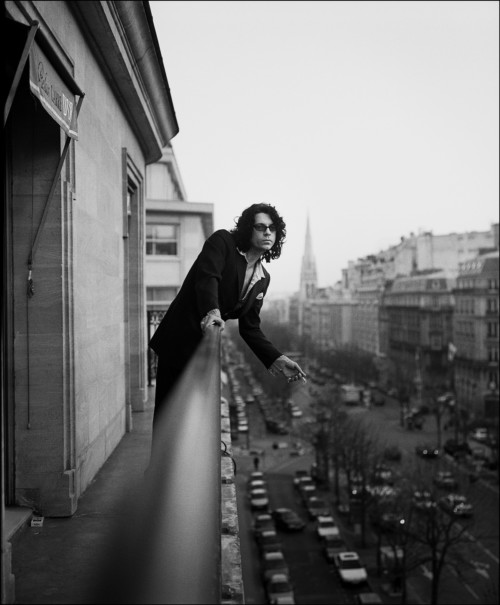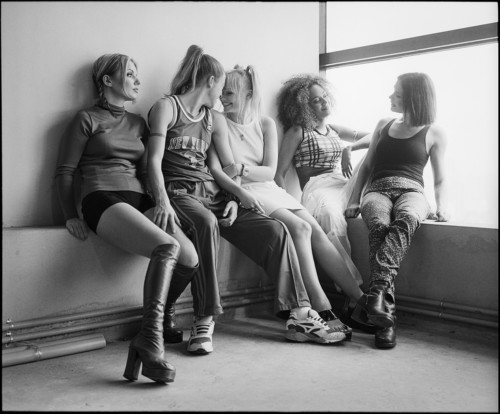-
Harry Borden: Radiohead (2007)
£ 625 – £ 5,800Radiohead photographed at Holborn Studios, London, 2007 In 2007 I photographed Radiohead for the Observer Music Monthly. They were about to release their seventh album, In Rainbows. They were also a more cerebral outfit than most other bands, so I thought carefully about how I would photograph them. I definitely didn’t want to turn up completely unarmed to photograph a band of hip and savvy people. The Observer had hired a room at Holborn Studios in north London, but I aimed to do something different from the average studio shoot. I wanted to approach it from an alternative angle, to include some element of performance and encourage the band members to be fully engaged and collaborative. With all that in mind, I came up with the concept of allowing the band to photograph themselves. I liked the idea because they seemed empowered and in control of their destiny, so it seemed an appropriate approach, as well as being quite funny. I talked it through with the magazine’s editor, who agreed, then bought an infrared cable release so the band could fire the camera’s shutter. When they arrived for the shoot, I explained the idea to them and they were really up for it, so I went ahead with setting it up. We had the biggest studio at Holborn. The equipment included a splendid block and tackle arrangement that I’d often admired, so I decided to incorporate it in the shoot. I attached one light to it with an Octa softbox, which I love using. I only used one light because when it comes to lighting I always believe that less is more. My Canon EOS 1Ds Mark II was set up on a tripod with a 50mm lens attached. I asked the band to stand under the Octa and arranged the band members with lead singer Thom Yorke at the front. Then I gave him the infrared cable release asked him to point it at the camera. I let him take the pictures until the memory card was full. One of those images was used on the cover of Observer Music Monthly. After we had done that scenario, I borrowed my assistant’s 1DS Mark II and asked the band to stand in the same places as they were when taking their own picture. Then I switched the radio sync to my assistant’s camera and shot the whole set-up from a different angle. I got some frames of my assistant standing by the camera, but ultimately the set-up worked best when it was just the band taking pictures. My favourite shot, shown here, has Thom Yorke giving a knowing look to my camera. This picture was used inside the magazine. As well as being something different and eye-catching, it works well because I think the picture references the kind of band Radiohead is. Available in a choice of physical size options. Please ask for framing options. Please allow 2-3 weeks between order and delivery for an unframed photograph. Framing adds 2-3 weeks. -
Harry Borden: Jarvis Cocker, London (1998)
£ 625 – £ 5,800Jarvis Cocker photographed in Waterlow Park, London, March 1998 Harry Borden recalls the session with the Pulp frontman: "I took this photograph in March 1998. By that time Pulp had recorded two major hit albums: His ‘n’ Hers (1994) and Different Class (1995), which featured several iconic singles including ‘Common People’. By this stage Jarvis was a superstar, established as part of the cultural landscape and featured frequently in the newspapers. I was doing the shoot for the Observer and he was being interviewed by journalist Lynn Barber at her house in Highgate, London. Using my Hasselblad, I took some pictures around the house, including in her daughter’s bedroom. The original idea was to move on and shoot some pictures in Highgate Cemetery, but I felt it wasn’t really appropriate for him as he wouldn’t have fitted into that Gothic environment. Instead we went to nearby Waterlow Park and shot more images there. Towards the end of the shoot I asked him to zip up the hood of his snorkel parka coat, so only his big, reflective glasses were visible. I liked the idea of being confronted with someone famous and playing with the fact that it’s really them. I was concerned his face would be too dark, so I used a handheld exposure meter to take a reading of the light going into the hood. By exposing only for his face, the line of trees in the background was blown out because it was overexposed. The result was a graphic and intriguing picture. It is possible that I had David Bailey’s portrait of Mick Jagger in a fur hood in mind when taking this picture. Rather than just copy a famous image, I try to take an idea and use it as a basis to create something that is different and original. This way, rather than getting a pastiche, you get a genuine moment. The line of trees in my picture gives it a kind of municipal ordinariness that suits Jarvis’s style and takes it on to another level. " Available in a choice of physical size options. Please ask for framing options. Please allow 2-3 weeks between order and delivery for an unframed photograph. Framing adds 2-3 weeks. -
Harry Borden: Michael Hutchence, Paris (1997)
£ 625 – £ 5,800Michael Hutchence pauses for a cigarette on the balcony of his hotel on the Champs Élysées, Paris, March 1997 This portrait of Michael Hutchence has become one of Harry Borden's best known images. Harry recalls a memorable week spent with the tragically short-lived INXS singer: "In March 1997, I was asked by The Observer to photograph him in Paris, where he was promoting INXS’s latest single, "Elegantly Wasted". It was a great commission and involved me staying at a really nice hotel on the Champs-Élysées for a week – where Hutchence was also staying. However, as we had to fit the shoots around him doing interviews and performing on pop shows, there was a lot of waiting around. I saw him perform the new single over and over again. He was, at that time, 37 years old and had been in the business for more than 20 years, but was still a mesmerising performer and had a lithe, panther-like quality. He had a great voice and his on-stage presence helped make the band really successful. One day I was out on the hotel balcony, trying to keep out of the way while he was doing a television interview in his room. At one point, he came out to have a cigarette. I had my camera with me and he just posed for me briefly, without either of us actually acknowledging that he was posing. As he looked past me, into the distance, his mind seemed to be somewhere else. It was a genuine moment. Having got to know Hutchence quite well during my week in Paris, it was a shock when, just nine months later, he was tragically found dead in a Sydney hotel room. The official verdict was suicide. The following year, the balcony shot was shortlisted for the John Kobal Portrait Award, and the Australian National Portrait Gallery contacted me to say they wanted it in their collection. Later, some of my other Michael Hutchence images featured on the sleeve of his posthumously released solo album. Since then, the balcony portrait has taken on a life of its own and has become one of my best-known photographs. The fact that Hutchence had died in a hotel room has undoubtedly given the portrait added poignancy. " Available in a choice of physical size options. Please ask for framing options. Please allow 2-3 weeks between order and delivery for an unframed photograph. Framing adds 2-3 weeks. -
Harry Borden: The Spice Girls, Bangkok (1996)
£ 625 – £ 5,800The Spice Girls, Bangkok 1996. L to R: Geri Halliwell, Melanie Chisholm, Emma Bunton, Melanie Brown, and Victoria Adams (later Victoria Beckham) Harry Borden photographed the Spice girls on four occasions and this is his favourite Spice Girls image. Harry explains: "The location for the shoot was a half-built tower block in the centre of Bangkok, chosen because their record company’s offices were on a lower floor of the building. After shooting a number of pictures on the roof, we came down to the office and they sat down, exhausted by the heat. I immediately saw that this scene would make a much better picture than the others I’d taken. So I quickly asked them to hold their positions and shot a few frames, using my Fujifilm 6x7 rangefinder, with Kodak Tri-X film." "There’s a wonderful line going through it, partly because of the way they are touching or linking arms, and the interplay between the two pairs of girls looks very natural. I also like the variation in light; Geri, on the left, is lit like a figure from a Renaissance painting, while Victoria on the other side of the frame is backlit. The fact that Geri is looking slightly distant is also appropriate; she was older and more worldly than the others and went on to leave the group in 1998. The picture only came about because I was alive to the situation and didn’t switch off - and shows that sometimes magic happens when you’re not trying too hard. A print is now in the permanent collection of The National Portrait Gallery." Available in a choice of physical size options. Please ask for framing options. Please allow 2-3 weeks between order and delivery for an unframed photograph. Framing adds 2-3 weeks.




